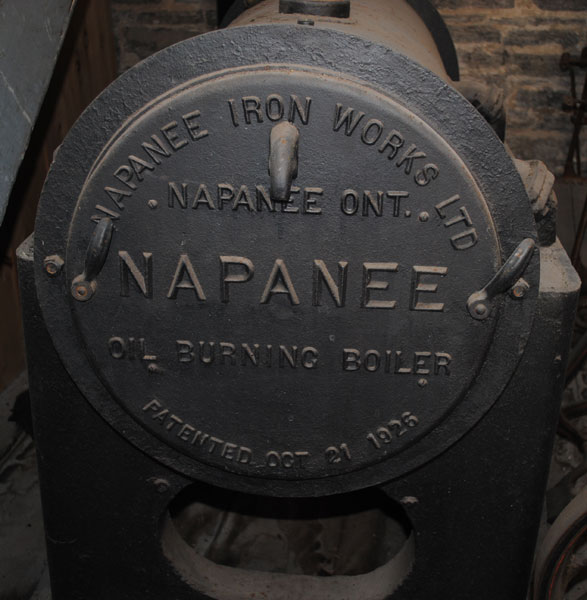
Between the Wars (1920-1940)Napanee Iron Works' Boilers |
|||
|
|||
A Napanee Iron Works oil burning boiler, patented 1926 |
The Dominion Rock Drill and Foundry Company, the precursor to the Napanee Iron Works, began in 1900, and specialized in the small scale production of Empire rock drills and steams hoists. Later, they expanded to include a line of iron castings. DISCOVER MORE![]()
Originally the company occupied a stone building on Mill Street just off Centre Street, Napanee. Machine and blacksmith shops, as well as space for moulding and patterning, were added to the premises. The shop did not have electricity, waterworks, or a sewer, but ran with lights powered by a steam engine. Water was pumped directly from the river. Company salesmen could carry a small sample drill to potential customers, in order to show a functional, small scale version of the full-sized product, complete with handle and interchangeable drill bits.
The business was operated by a board of directors that included John M. Wallace, Dr. Richard Conway Cartwright, Dr. John P. Vrooman, and Edmund John Roy, who served as manager, and later as president. At one time, the business employed seventeen people with a weekly payroll in 1981 of $200. Pay stubs from 1909 indicate that a worker earned a weekly wage of $3.27 for working ten hours days, six days a week.
By 1912, the operation had grown immensely, and the company was capitalized at $200,000. To meet demand, the company reorganized as the Napanee Iron Works Limited, and moved to a new location at Ann Street and West Street along the railway line. The new site provided many more amenities, and a significant improvement in space, offering room for an office, machine shop complete with travelling crane, an erecting room, a pattern shop, a blacksmith shop, a storage room, a foundry, an electrical shop, and a boiler shop. Electricity, plumbing, ventilation, and a reading and lunch room were also included. The building was more than 150 feet square, and was supported by a steel frame.
At this time, the Iron Works began producing boilers, which would become their signature product. The Iron Works could produce an entire boiler on-site, constructing coal and wood-fired models. Steel plate was cut, rolled to shape and riveted, and head, back plates and boiler tubing was installed. After testing, fitments and controls were added to the assembly. The boilers were then shipped out by railway flat car to its destination.
During the First World War, the Iron Works manufactured artillery shells in the tool room. During the Second World War, the firm's machine shop produced fitments for the Royal Canadian Navy and machined shafts for naval vessels.
On the domestic side of production, the Royoil, an oil burning boiler was designed and produced during this period. Likely, the boiler was named after E.J. Roy who managed the Dominion Rock Drill and Foundry Company. After the Second World War, the Iron Works continued to expand and modernize, becoming one of the largest industries in Napanee. E.J. Roy's son, Wallace Roy and William Palm, an American, collaborated, in designing automatic oil and gas-fired boilers, using both both steam and hot water. These proved so successful that an addition to the boiler shop was required. These highly efficient boilers were purchased by customers from coast to coast, and as far away as Australia and New Zealand.
In 1956, the Napanee Iron Works was purchased by International Equipment of Montreal.
© Lennox & Addington County Museum & Archives
97 Thomas Street East, Napanee, Ontario, Canada K7R 4B9
Funding provided by the Government of Ontario and the County of Lennox & Addington




